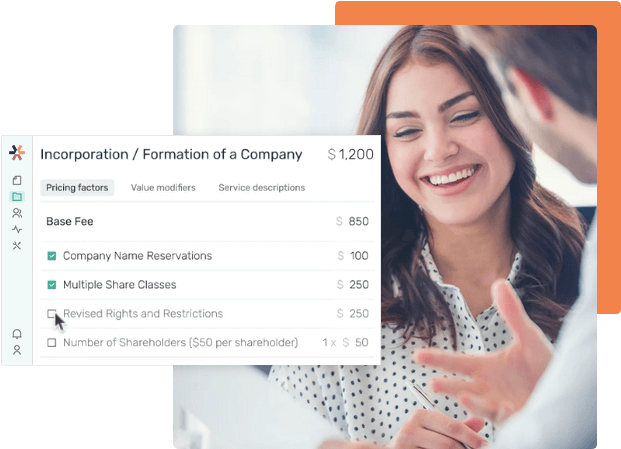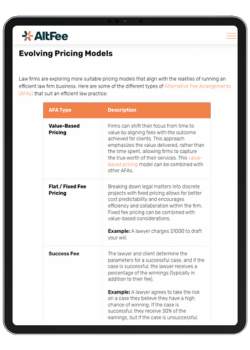- Resources
- Flat Fee Pricing for Lawyers: Why Use Them & How to Not Lose Money
Table of Contents
Of all the alternative fee arrangements, flat fees are probably the most straightforward and easy-to-understand fee type. It’s simple to explain to a client—you pay $500 for this legal service—and it’s easy to bill.
You’ve probably already seen some positive impact from charging flat fees to your clients. Because this AFA is easy to explain and invoice, chances are you’ve seen improvements to your realization and collection rates.
And this isn’t just an assumption based on thin air—there’s a reason why when you do a Google search for “flat fee attorney,” you’re likely to get a fair number of hits for law firms in your area offering flat or fixed rates for certain services.
But as you’ve likely realized, flat fees aren’t all sunshine and rainbows. Yes, it provides better price certainty for your clients, and yes, it’s easy to bill, but there’s also an inherent risk of losing money. Lost income generally happens when you’ve miscalculated how much time and energy a matter will require tipping the resource-profit scale a little too much on the resource side for you or your firm’s liking.
In this article, we’ll explore the basics of flat fees, how NOT to lose money when charging flat fees, and provide guidance for implementing flat fees successfully.
What Is a Flat Fee?
A flat fee is extremely simple: a lawyer charges one total fee in exchange for a legal service or services. Typically, a lawyer will charge a flat fee for straightforward legal tasks, such as:
- Signing a document as a notary public
- Residential real estate services
- Wills and estates administration
- Corporate and business legal services like incorporation, minute book preparation, and shareholder agreement creation
Some firms may provide flat fee billing for more complex legal services, but it comes at a bit of a risk because of the potential for a higher workload than the attorney was expecting, leading to a potential loss of profit. However, by combining experience,collaboration, and the right pricing software it’s possible to set a flat fee for more complex services.
Why Should Legal Firms Charge Flat Fees?
Charging attorney flat fees has various benefits for the lawyer, client, and law firm. Let’s explore a few of these benefits further.
Provides 100% Price Certainty for Your Client
A client that knows what they are expected to pay for their legal services from the beginning will be more likely to pay their bill in full when the time comes. Aside from increasing your collection rate, providing better price certainty for your clients is also much more likely to gain you additional or repeat business.
- In the 2022 Clio Legal Trends Report, over 1,000 members of the general public in the United States were surveyed, asking them to rate the most important factors that affect whether they will hire one lawyer over another. The results indicate that one of the most important factors in deciding whether to hire a lawyer (though not as important as reviews, or location and response time—which both scored equally in terms of importance) is how a law firm bills.
- Additional survey data from this report indicates that 67% of consumers want the option to pay for legal services via flat fees. Offering a flat rate is, at this point, meeting the demands of clients by setting the expectation that they will receive a straightforward bill.
Provides a More Straightforward Billing Process
A flat fee attorney has the benefit of providing clients with a straightforward billing process from the beginning of the interaction, often supported by technology like AFA pricing software, automated law firm billing systems, and online payments. Here’s a high-level example of how pricing and billing could work for an attorney flat fee:
- Pricing is set out for a matter via pricing software such as AltFee. Setting prices for clients with AltFee allows you to price matters in minutes while at the same time optimizing your pricing over time through collaboration with colleagues. Let’s say you’d like to set a flat fee for estate administrative services. AltFee provides a template with a base fee for this type of project as well as a breakdown of factors/tasks to consider like identifying the estate assets and liabilities, satisfying the debts of the estates, and providing a set fee for each factor. As relevant factors are selected a total flat fee is automatically calculated. Attorneys can then use AltFee’s Description of Services feature to create a client facing summary of scope which they’re able to export into an engagement letter or email. Collaboration with colleagues means pricing factors can be adjusted over time based on new information and learnings, allowing the firm or the lawyer to ensure that pricing is always up-to-date.
- Legal e billing software or other billing software is used to create an invoice and take payments. Using the information from the pricing software, invoices to send to clients can be created easily. Clients can then pay their bills online using their credit card or a service like PayPal. Attorneys taking too long to send out a bill can cause payment delays or even worse yet, cause the attorney or law firm to lose their right to request payment for services. In Ontario, for example, although a law firm has the right to sue a client for an unpaid balance, delays in sending the invoice can significantly affect the case's legitimacy. Two years from the time work has been completed may seem like plenty of time to send a client a bill, but courts might not be so forgiving with such a delay these days, especially with electronic billing and payment options being so common.
Start Earning More Revenue with Fixed Fees
Break free from hourly pricing and take the fear out of scoping and pricing client projects to start maximizing profitability.
Book A Demo
Reduces Administrative Work
From straightforward pricing strategies to simple and upfront payments from clients, flat fee billing makes it easier to manage the cost of legal services. Billing by the hour requires a lawyer to track their time, fuss over work reports, and divide their hourly rate into 6-minute increments. All this takes a ton of administrative time that could be spent working on other legal cases. With flat fees, pricing and billing is straightforward, easy to manage, and doesn't require the lawyer to meticulously track every minute of their day.
4 Reasons Flat Fee Attorneys Earn More
Building off of the benefits of flat fees, there’s a variety of reasons why attorneys who charge a flat fee for legal services are better positioned to earn more than their counterparts who still bill by the hour. These reasons are outlined in more detail below:
1. Promotes Efficiency
A popular viewpoint on the billable hour is that it incentivizes attorneys to work slower, which in a lot of cases this view can be compounded by the firm’s compensation structure, where they expect lawyers to work a certain number of hours per year. A flat fee attorney, however, is more inclined to work efficiently because the faster they are able to work, the higher the margin is on the flat fee. With the time they claim back through improved efficiencies, attorney can choose to work less hours and make the same living or, earn more by taking on more projects with the additional time they have for client matters.
2. Utilizes Technology
Because charging a flat fee incentivizes more efficient work, legal technology is essential for helping the lawyer prioritize tasks and communications and deliver work faster. Legal software solutions such as a legal practice CRM, knowledge management software, case management system, pricing, and billing software are all strategic assets that a lawyer or a firm can utilize to work more effectively and efficiently.
3. Gives a Competitive Advantage
Compared to other firms or solo practitioners that offer hourly billing, flat fee and other forms of non-hourly billing are often the more attractive option for consumers. Flat fee billing offers price certainty, allows a client to budget in advance to pay the final bill when it's due, and reduces the stress and worry on the lawyer and the client with regard to fees—the lawyer doesn’t have to worry about tracking every minute of their time, and the client can be assured that communications won’t cost them extra. This alignment of lawyer-client interests is a game-changer. However, it is up to the lawyer to set clear boundaries at the outset so that the client understands that they can’t simply contact the lawyer at all hours because it won’t cost them anything. This is where technology assists as well. Some practice management software offerings provide a client-facing portal, for example, where the client can log in and see the current status of their case, leave messages for their lawyer, and even upload documents if needed.
4. Emphasizes the Value of the Attorney’s Work Rather Than Time
Like other AFAs, a lawyer can utilize the flat fee to charge based on the value of the work provided rather than be limited by the billable hour. Pricing based on perceived value requires a bit of planning and strategy, but value-based pricing often allows lawyers to charge more while still ensuring the client is satisfied with the price because they are meeting the client’s expectations concerning perceived value. In other words, it’s worth the effort.
How to Implement Attorney Flat Fee Pricing Successfully
If you’ve delved into charging flat fees or other Alternative Fee Arrangements, you know planning is required. It would be incorrect to suggest that flat fee pricing is this perfect, problem-free way of charging clients while giving lawyers and law firms more benefits. However, with some considerations, flat fee pricing can be implemented successfully.
1. Understand that Getting Flat Fees Right Can Take Time
Perhaps one of the biggest challenges with flat fees is also the one that has the most payoff in the end when you get it right. The challenge at first is usually learning how to manage projects effectively and efficiently, as well as ensuring that the fee charged makes sense for both the client and the attorney. It’s the AFA that likely seems the least intimidating to firms switching from hourly billing, but even if your firm has been using other forms of AFAs for a while, it’s important to understand that flat fees, just like other forms of AFAs are not a magic bullet that you can implement and forget about, it takes time and optimization to get it right. However, suppose you put in the work to shift attitudes about equating an hour to a dollar amount or determining whether a fee is reasonable or unreasonable to get the value of service to dollar ratio right. In that case, the payoff is easier billing, better work-life balance, and potentially higher collection and realization rates.
2. Understand Your Costs
To set flat fees effectively and avoid losing money, it’s important that you fully understand the attorney costs involved with every case. In some cases, this may be as easy as bundling together typical fees like disbursements into the flat fee cost, but in other instances, it may not be as simple.
In some areas of law, it may be more difficult to set effective flat fees because cases can differ significantly, even when they are for the same legal issue on paper. For instance, in personal injury law, two seemingly identical cases can have different outcomes, even when the plaintiff has the same disability or claim and the defendant is the same insurance company.
In the United States, fee-shifting statutes may add further uncertainty because they can vary, potentially leading to extra costs with a case that may or may not be charged depending on the outcome of the matter. With fee shifting, the losing party in a legal matter may have to pay for the legal fees and other costs of the winning party. If this is a risk in a particular case, then the solution to this issue may be to simply use another type of AFA (such as a staged or phased fee) or to set specific flat fees based on individual cases.
3. Collaborate with Colleagues to Set Prices
One of the most important ways to set effective flat fee prices for your legal services is to collaborate with colleagues on pricing initiatives. Talking about what they typically charge for a service or hashing out what certain granular tasks should cost goes a long way to setting effective pricing.
AltFee offers built-in collaboration within the platform, so you and your team can easily communicate with each other on specific client pricing without relying on an external platform. Requests can even be made to update pricing based on new information or attorney experience.
Start Earning More Revenue with Fixed Fees
Break free from hourly pricing and take the fear out of scoping and pricing client projects to start maximizing profitability.
Book A Demo
4. Watch for Scope Creep
Clearly defining a project's scope, especially when engaging with flat fee billing, is important. The client should be fully aware and agree to what is and is not included in the project so they are not under the impression that they can ask for more work to be completed and not have to pay an additional cost. This is an area where collaboration with colleagues is invaluable, as experience plays a huge role in understanding how much work would typically be involved in a case from different perspectives. While there’s always the risk that you may price too low, having conversations with the client as early as possible helps tremendously if the scope does need to change and, subsequently, the flat fee.
Attorney Flat Fee vs Hourly Attorney Billing
When compared to each other, it’s easy to see the benefits of flat fee billing versus billing at an hourly rate:
|
Flat Fee BIlling |
Hourly Billing |
|
Provides an easy, straightforward way to charge for legal services |
Straightforward legal services may be charged at the same rate as complex legal services due to the limitations of the billable hour model (i.e. an attorney’s time is charged out at the same hourly rate regardless of project type) |
|
Provides better cost certainty for clients, which often results in higher collection and realization rates |
May cause sticker shock, increasing the likelihood that a client will contest their final bill, potentially resulting in discounts/writeoffs or unpaid bills |
|
Better matches the value of a legal service to price |
Causes the client to focus more on price rather than focusing on the value of the legal service provided |
|
Easy to explain to a client |
May be easy to explain to clients, but lawyers and clients alike are often hyper focused on factors that affect the final price, a big one being time spent on the case, including communications like calls and emails that affect the final bill |
|
Allows the attorney to better reflect the complexity of the work performed to the price of the legal service |
Depending on the firm’s culture and the client, an attorney may either feel obligated to work longer hours to meet quotas, or feel that they need to rush through cases to get through more clients |
|
Allows for better work-life balance for the attorney and legal professionals |
Often results in lawyer and legal professional burnout |
How to Determine the Pricing of Flat Fee for Attorney?
Determining the most effective way to flat fee price for a legal service requires some consideration and planning. The first instinct of legal professionals may be to take a “cost plus” approach, where you’re trying to incorporate all fixed and variable costs into the flat fee price to account for your base costs and any potential extras. But this approach doesn’t convey the full value of the legal service, so you’re likely underselling yourself and leaving money on the table if you base your flat fee on the cost-plus method.
|
Value-Based Pricing |
Cost Plus Approach |
|
Pricing is set based on the client’s perceived value of the legal service. |
Pricing is set based on your costs, as well as potential variable costs. |
|
With a value-based pricing approach, lawyers are often able to price their services higher, and the client remains satisfied with the price (because they understand the value they are getting) |
With a cost-plus approach, the client will likely be unclear as to how the lawyer arrived at the price, and a “variable costs” line item may not make the most sense to the client |
In our blog value-based pricing vs cost-based pricing, the main techniques that were outlined in determining how to price legal services based on value can be summarized as follows:
- Listen to the client’s situation in full.
- Ask them specific “why” questions—why must this problem be solved now? What are the potential consequences if it isn’t solved?
- Using this information, you should now know how much the project is worth to the client. You should also understand the overall scope of the project. By consulting with colleagues and drawing from their experience, as well as doing further research on what other firms are charging in your area, you should be able to set a flat fee price for the project.
Why AltFee Is the Best Choice for Attorney Flat Fees Pricing
In the last decade, the conversation about Alternative Fee Arrangements in the legal industry has grown, leading to more firms than ever before embracing AFAs in favor of the traditional billable hour. These days, there are law firms that have eliminated the billable hour entirely in favor of AFAs, while others are experimenting with a blend of fee structures. Whether you fall in the category of a firm that’s eliminated billing by the hour entirely or is just experimenting with AFAs, you need an effective way to systemize and manage your pricing.
AltFee brings together the creation, management, and collaboration behind flat fee pricing by centralizing all of these tasks on one platform. This way, your AFA pricing can stay organized, you can work more efficiently with customizable templates that reflect current industry pricing trends, and offer a more seamless legal experience to your clients.
Conclusion
Flat fee pricing is an effective AFA pricing strategy that gives clients price certainty, allows legal professionals to price their services based on value and helps law firms increase their collection and realization rates.
When clients understand and agree with the price that they are paying for a legal service, they are much more likely to pay their bills in full and on time. Further, pricing based on value often allows legal professionals to better understand their client’s perception of the value that the legal service provides them, potentially allowing the legal professional to charge more for their services.
If you’re interested in learning more about AltFee and how the software can help you effectively manage your AFAs, then get in touch with us today.
Start Earning More Revenue with Fixed Fees
Break free from hourly pricing and take the fear out of scoping and pricing client projects to start maximizing profitability.
Book A Demo





Newsletter Signup
Subscribe to our newsletter to receive the latest news.




